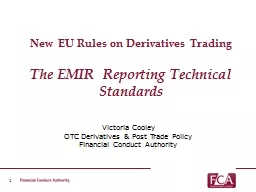

The EMIR Reporting Technical Standards Victoria Cooley OTC Derivatives amp Post Trade Policy Financial Conduct Authority 1 2 Agenda Introduction to EMIR The reporting requirements ID: 707369
Download Presentation The PPT/PDF document "New EU Rules on Derivatives Trading" is the property of its rightful owner. Permission is granted to download and print the materials on this web site for personal, non-commercial use only, and to display it on your personal computer provided you do not modify the materials and that you retain all copyright notices contained in the materials. By downloading content from our website, you accept the terms of this agreement.
Slide1
New EU Rules on Derivatives TradingThe EMIR Reporting Technical Standards
Victoria CooleyOTC Derivatives & Post Trade PolicyFinancial Conduct Authority
1Slide2
2AgendaIntroduction to EMIR
The reporting requirementsFrequently asked questionsReporting to trade repositoriesSlide3
3IntroductionG20 statement in Pittsburgh:
All standardised OTC derivative contracts should be traded on exchanges or electronic trading platforms, where appropriate, and cleared through central counterparties by end-2012 at the latest. OTC derivative contracts should be reported to trade repositories. Non-centrally cleared contracts should be subject to higher capital requirements. Slide4
4The reporting requirementsSlide5
5Reporting obligation
Applies to all counterparties to all derivative contracts (OTC and exchange traded)Information to be reported to TRs - about 60 data fields in total!
Basic trade information, ‘who, what, when, how many and how much’;
- the parties to the contract (or the beneficiary)
- type of contract
- maturity
- notional value
- price
- settlement date
- unique trade identification
- amendments to tradeSlide6
6Reporting of exposures
Essential for monitoring systemic riskOnly financial and non-financial counterparties (NFC) above the clearing threshold are required to report exposuresInformation to be reported daily; - Mark to market or model valuations
- Collateral value and basis (transaction or portfolio)
6 month transitional from reporting start dates for reporting exposures informationSlide7
7Timeline for reporting
Credit and interest rate derivatives; - If no registered TRs by 1 April – 90 days after registration - Expected mid-September 2013For all other derivatives;
- If TR is registered by 1 October - reporting
begins 1 January 2014
- If no registered TRs by 1 October – 90 days
after registrationSlide8
8Timeline for reporting
Backloading of existing tradesIf outstanding at time of reporting date; - 90 days to report to TR - report in current position
If not outstanding, but remained outstanding on 16 August 2012;
-
3 years to report to TR
- report final positionSlide9
Frequently asked questions9Slide10
10Frequently asked questionsThere is a need to ensure harmonisation of reporting across EU
ESMA published 1st set of Q&As in March 2013Expected to be an iterative process
Need for immediate Q&As for trading scenarios, give up trades, block/allocation tradesSlide11
Frequently asked questionsStill some uncertainty around interpretation
Work is ongoing to establish how EMIR applies in some situationsRest of the presentation represents current FCA views and may be subject to further clarification by either the European Commission or ESMA
11Slide12
12Clearing models
If the process involves creation of a bilateral trade followed by novation, separate reports likely to be requiredIf clearing is instantaneous and no bilateral trade exists, only the cleared trade should need to be reportedCorrect approach where novation occurs very quickly after bilateral execution still subject to discussionSlide13
Who has reporting obligationBrokers and dealers do not have a reporting obligation when they act purely in an agency capacity
Still some uncertainty over how to report transactions where a broker, dealer or clearing member clears or facilitates a transaction for a client on a principle basis13Slide14
14Give up trades
Only counterparties to the contract have reporting obligationTypically, counterparty and CCP would reportApproach still to be agreed at EU levelSlide15
15Reporting of block/allocation trades
No exemptions – reporting obligation applies to all derivative transactionsIf block trade gives rise to multiple transactions, each of those would have to be reportedProcess still to be agreed at EU level however we expect both stages to be reportedSlide16
16Reporting to trade repositoriesSlide17
17How to fulfil reporting obligation
Both counterparties MUST report each trade unless by prior arrangement, one party can report on behalf of both counterparties Either counterparty may also delegate reporting to a third-party (such as a CCP or trading platform)Likely through contractual obligations with one another which should set out what information is to be reported
Regulatory responsibility remains
with original counterpartiesSlide18
Practical preparationsFirms either have to establish delegated reporting arrangements or direct connectivity with a TR
If delegating; - make sure delegate is willing to accept the delegation (including for any intragroup trades) - have processes in place to ensure that reports submitted on your behalf are accurateIf want to connect directly to a TR;
- start now
- consider whether TR(s) will be authorised in time
- will TR cover all asset classes for all reporting
obligations
18Slide19
Legal entity identifiers (LEI) - ROC established January - Expect Central Operating Unit to be formed
in April/May - Interim phase – Local Operating Units - Expect pre-LEIs code to be mutually recognised
19
IdentifiersSlide20
20IdentifiersUnique product identifiers
- No agreed EU UPI - Existing codes, ESMA taxonomyUnique trade identifiers - No agreed EU UTI - Counterparty generates and agrees with other counterparty
- Lifecycle events include UTI linked to
original UTISlide21
21Further information – visit our website
www.fca.org.uk/firms/markets/international-markets/emirLinks to Commission and ESMA publicationsLink to ESMA Q&ALink to FCA consultationsEMIR mailing listSlide22
22
Any questions?